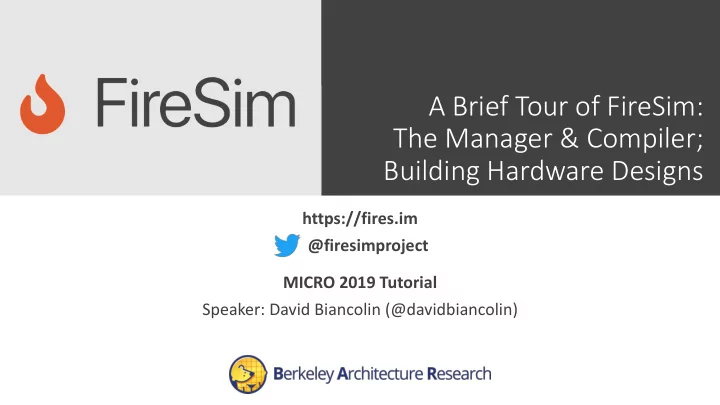

A Brief Tour of FireSim: The Manager & Compiler; Building Hardware Designs https://fires.im @firesimproject MICRO 2019 Tutorial Speaker: David Biancolin (@davidbiancolin)
Agenda: What Will We Cover? 1) The Compiler à Golden Gate • Invoke it on example RTL • Inspect its outputs 2) The Manager à firesim • Explain how it’s configured • Demonstrate how it’s used to build bitstreams 2
Where is FireSim in Chipyard? With the software RTL simulators! ~/chipyard-afternoon/sims/firesim à This has been exported as $FDIR 3
Interactive: # <ssh back onto your ec2 instance> $ tmux new –s afternoon $ cd $FDIR $ ls 4
FireSim’s Directory Structure sim / • Golden Gate lives here • Scala & C++ sources for additional FireSim models • Make-based build system to invoke Golden Gate deploy/ • Manager lives here • FireSim workload definitions platforms/ à AWS FPGA/Vivado project definitions sw/ à target software & FireMarshal (more on this later) 5
Agenda: What Will We Cover? 1) The Compiler à “Golden Gate” • Invoke it on example RTL • Inspect its outputs 2) The Manager à firesim • Explain how it’s configured • Demonstrate how it’s used to build bitstreams 6
Interactive: $ cd $FDIR/sim $ make DESIGN=FireSimNoNIC 7
An Analogy • Golden Gate is like Verilator but for FPGA-accelerated simulation Verilator generates C++ sources to simulate your design. à Compile and run on a CPU-host Golden Gate generates C++ & Verilog to simulate your design. à Compile and run on a hybrid CPU & FPGA host 8
Golden Gate Compiler Inputs: • FIRRTL & annos from a Chipyard generator • Compiler configuration à Produces sources for a simulator that are: • deterministic • support co-simulation of software models • area-optimized to fit more on the FPGA 9
Plug: ICCAD 2019 Publication Punchline: à Can fit two more BOOM cores (4 -> 6) à think: “–Os for FireSim” These optimizations ship with FireSim 1.7.0! 10
Interacting with Golden Gate via Make • Make invokes Golden Gate with three variables (the “Tuple”): DESIGN : • The top level module à MODEL in Chipyard TARGET_CONFIG: • The generator’s config à CONFIG in Chipyard PLATFORM_CONFIG: • Compiler options passed to Golden Gate 11
Interactive: $ cd $FDIR/sim/generated-src/f1 # here you’ll find output directories for all builds $ cd <any-directory-here> $ ls 12
Inspecting the Outputs <long-name>.fir & <long-name>.anno.json • Target’s FIRRTL & annotations FPGATop.v • The compiled simulator $DESIGN-const.h • Simulator’s memory map runtime.conf • A default runtime configuration for simulation 13
Agenda: What Will We Cover? 1) The Compiler à Golden Gate • Invoke it on example RTL • Inspect its outputs 2) The Manager à firesim • Explain how it’s configured • Demonstrate how it’s used to build bitstreams 14
Background Terminology “AGFI”: FPGA Bitstream for F1 FPGAs 15
Using the firesim Manager Command Line • sourcing sourceme-f1-manager.sh puts firesim on your path • can call firesim from anywhere on the instance • it will always run from the directory: $FDIR/deploy/ After a fresh clone, need to call: firesim managerinit à You did this at the start of the tutorial 16
Interactive: $ cd $FDIR/deploy $ ls 17
Configuring the Manager. 4 files in firesim/deploy/ config_build_recipes.ini config_build.ini config_hwdb.ini config_runtime.ini 18
Configuring a Build config_build_recipes.ini config_build.ini config_hwdb.ini config_runtime.ini 19
Anatomy of a Build Recipe Consists of: • A label • The tuple from before • The EC2 instance type you’d like to build on 20
Defining a Build Job: config_build.ini Consists of: • More instance configurations • A list of recipes you’d like to batch out to a build farm Once you’re done with builds: • A list of recipes you’d like to share with other users 21
Running builds • Once we’ve configured what we want to build, let’s build it $ firesim buildafi • This completely automates the process. For each design, in-parallel: • Launch a build instance (c5.4xlarge) • Generate target RTL & invokes Golden Gate • Ship infrastructure to build instances, run Vivado FPGA builds in parallel • Collect results back onto manager instance $FDIR/deploy/results-build/<TIMESTAMP>-<tuple>/ • • Email you the entry to put into config_hwdb.ini • Terminate the build instance 22
Interactive: $ cd $FDIR/deploy # Should print the FPGA image from the AM $ cat built-hwdb-entries/* 23
Anatomy of a HWDB Entry • Same label as before • The FPGA image Hooks to change: • Software models • Runtime arguments à Without FPGA recompilation 24
Interactive: # Prefetching for the next section $ cd ~/chipyard-afternoon/software/firemarshal/ $ ./marshal -d build workloads/sha3-linux-test.json 25
Summary • Don’t fret if you didn’t catch everything, everything we showed you today is documented in excruciating detail at http://docs.fires.im • We learned how to: • Build FireSim FPGA images for a set of targets • http://docs.fires.im/en/latest/Building-a-FireSim-AFI.html 26
Backup Slides 27
Interactive: $ cd $FDIR/deploy $ cd results-build/<name>/cl_firesim $ ls 28
Captured Build Outputs design / • The source files for the build; build/scripts/<timestamp>.vivado.log • Log of the entire vivado build process build/reports/ • Timing and utilization reports from various stages build/checkpoints/ • Design checkpoints (*.dcp); can reopen in Vivado to debug a build 29
Interactive: cd $FDIR/sim make run-asm-tests <wait for one test to complete> ctrl-c 30
Simulating the Simulator • Can simulate Golden Gate’s output without doing an FPGA-build • Runs with all the same models you’d have on the FPGA • Should produce target-cycle-exact behavior as an FPGA simulation à outputs in output/f1/<tuple> 31
Recommend
More recommend